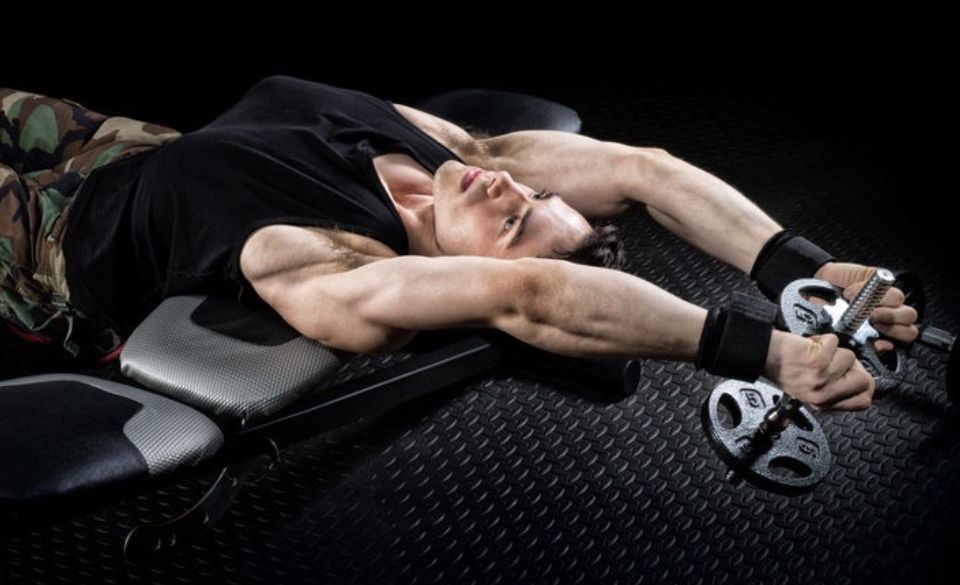
Dumbbell Pullover – Everything You Need To Know
Page Contents
If you’re like most people, when you think of strength-training exercises, the first thing that comes to mind is the most common weight exercises – bench press, squat, Leg press. But there are other options out there, and one of them is the dumbbell pullover. This underrated exercise can help you build strength and muscle in your chest, shoulders and arms. It’s worth adding to your routine!
What Is A Dumbbell Pullover
A dumbbell pullover is a weighted exercise that usually involves a workout bench. The pullover motion involves holding the dumbbell in your hand and moving it from in front of you to behind you, over your head. It’s a somewhat advanced move due to the equipment needed as well as the form required.
Dumbbell pullovers strengthen and target your lats first and foremost, which is the largest muscle in your upper back. These pullovers also use and strengthen your pecs, serratus anterior, triceps, and core. They are used to “improve thoracic spine mobility.
Dumbbell pullovers can be performed with either one dumbbell or two dumbbells. If using one dumbbell, hold it with both hands. If using two dumbbells, hold them by their ends so that your palms are facing each other.
To do the exercise:
1. Start by lying on a flat bench with your feet flat on the floor and with your knees bent. If using one dumbbell, hold it over your chest with both hands extended straight overhead. If using two dumbbells, hold them at arm’s length above you with your palms facing each other. This is the starting position.
2. From the starting position, slowly lower the weight behind your head until your arms are parallel to the floor. Be sure to keep your elbows slightly bent throughout the movement.
3. Reverse the motion, and slowly raise the weight back to the starting position.
4. Repeat for the desired number of repetitions.
Dumbbell pullovers are a great exercise for targeting the muscles of the back, but they can also be used to work the chest and arm muscles as well. Be sure to use proper form when performing this exercise, and always consult with a doctor or certified personal trainer before adding any new exercises to your workout routine.
Dumbbell Pullover Muscles Worked
The pecs are the main muscles that move the weight during dumbbell pullovers. In addition, the lats, teres major, triceps, anterior deltoids, and — depending on the grip — the wrist flexors all play a part in this exercise.
With a focus on technique, correct breathing, and placement of the spine, the abdominal muscles also engage, giving you the added benefit of core work. This makes dumbbell pullovers an excellent choice for those looking to build strength and muscle mass in a comprehensive way.
Dumbbell pullovers can be performed with a variety of grip widths and hand placements. This allows you to target different areas of the pecs, as well as work the muscles in slightly different ways. Experiment with different grips to find what works best for you.
Benefits
Dumbbell pullovers are a great exercise for the upper body. They can help to target the chest muscles, as well as the back muscles. The movement pattern of the exercise focuses on moving the arm in the shoulder joint, therefore creating mobility in this area.
Another benefit of dumbbell pullovers is that they can be done with different weights and sizes of dumbbells, making them accessible for people of all fitness levels. They can also be done at home or in the gym, making them convenient for busy people.
Additionally, dumbbell pullovers help to improve your posture and can be performed with relatively light weights. As a result, they are an ideal exercise for those who are new to weightlifting or who have existing injuries.
Dumbbell pullovers also have several benefits for your cardiovascular health. They can help to increase your heart rate and blood flow, which can improve your overall cardiovascular fitness. Additionally, dumbbell pullovers can help to reduce stress and anxiety levels. This is because they require you to use deep breathing techniques during the exercise. As a result, dumbbell pullovers can help you to relax and de-stress after a long day.
If you are looking for an exercise that is both effective and safe, then dumbbell pullovers are a great choice. However, it is important to ensure that you use the correct technique when performing this exercise. Incorrect form can lead to injury, so be sure to consult with a qualified instructor before beginning this or any other weightlifting exercise.
How To Do Dumbbell Pullovers With Proper Form
Start by sitting on a weight bench with your legs bent at 90 degrees and your feet flat on the floor. Place a dumbbell upright on your thighs, gripping it with both hands.
Keeping your lower back pressed firmly against the bench and your core engaged, use your arms to lift the dumbbell over your head until your arms are fully extended. From here, slowly lower the weight behind your head, maintaining control throughout the entire range of motion. Once you feel a stretch in your chest and shoulders, pause for a moment before returning to the starting position.
Repeat for 8-12 reps, or as needed.
Some Tips To Remember:
– Keep your core engaged and your lower back pressed against the bench throughout the entire exercise.
– Don’t arch your back as you lower the weight behind your head.
– Don’t let the weight touch your neck—lower it only as far as you can while maintaining good form.
– Focus on contracting your chest and shoulders as you lift the dumbbell back to the starting position.
When performing dumbbell pullovers, it’s important to keep good form top of mind to avoid injury. Use a light weight to start and focus on keeping your lower back pressed firmly against the bench throughout the entire exercise. Additionally, be sure to keep your core engaged and breathe steadily to maintain control of the dumbbell as you move through the range of motion.



